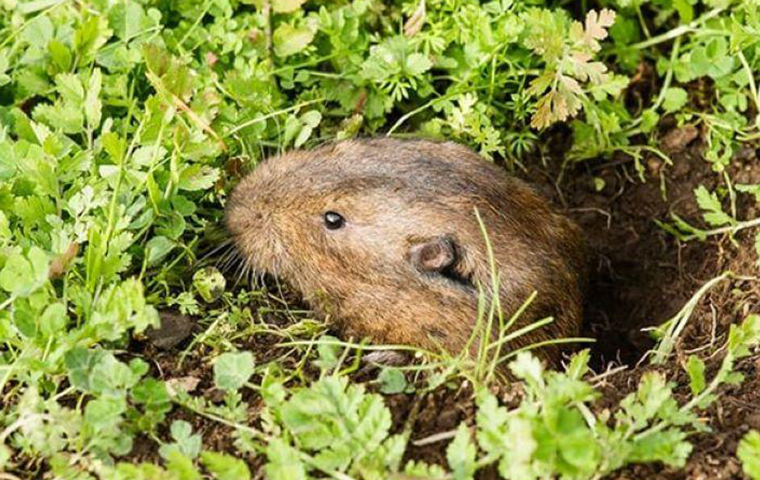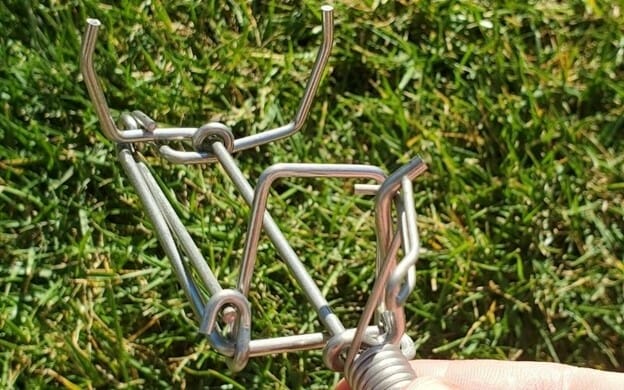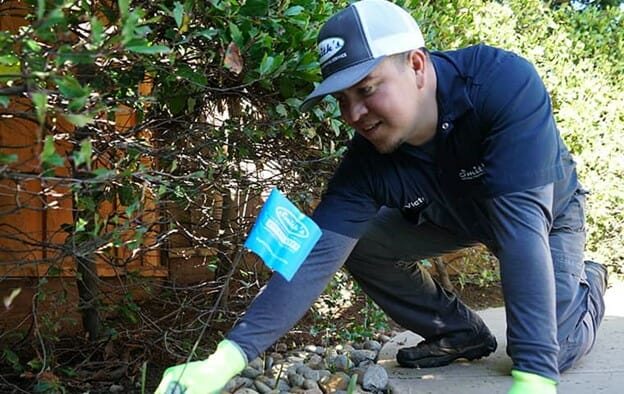Easy Way to Get Rid of Gophers in the Lawn
Your lawn and garden are your outdoor sanctuaries. Whether you're grilling dinner, entertaining friends, or simply relaxing after a long day, your outdoor space should be a haven.
Unfortunately, the presence of even a few gophers is enough to transform that peaceful space into a nightmare. With their unsightly holes and the damage they do to plants, gophers can quickly wreak havoc on landscaping.
Fortunately, there are ways to get rid of gophers and reclaim your property.
Here at Smith's Pest Management, our team has helped thousands of San Francisco Bay Area residents deal with their gopher problems once and for all, so we know how to get rid of these pesky rodents.
In this post, we'll share ourtop gopher control tips and help you understand which is best for you.
Let's dive in.
Why Do I Have Gophers in My Yard?

Humans aren't the only ones who love a beautiful yard! Here are a few things that may be drawing gophers to your property:
1. Food sources
Gophers need to eat, and they'll set up shop anywhere they can find food sources. Gophers are herbivores, meaning they only eat vegetation. They love roots and tubers of plants and seeded acorns but sometimes resort to "grazing the lawn for grass, clover, and other snacks."
2. Soil composition
Because gophers love to excavate, they prefer to live in areas with loose, sandy soil that's easy to move.
3. Shelter
Gophers are prey for many other animals, so they need plenty of protection to stay safe. They may build tunnels under bushes, along fence lines, or under trees.
Once you have a few gophers in your yard,the problem will snowball as the gophers reproduce.
Female gophers have between one and three litters per year, with each litter containing five to six pups. The young stay at their mother's side for a few weeks before going out on their own to build burrows and make tunnels.
With that in mind, it's smart to address gopher infestations quickly – before they become hard to manage.
How to Identify Gopher Damage in Your Yard and Garden
How to Get Rid of Gophers with Integrated Pest Management (IPM)
If you've identified gophers in your yard, you can get rid of them with an integrated pest management (IPM) approach.
IPM approaches combine natural and traditional pest management methods holistically to control pest species like gophers.
Here are a few IPM steps to get you started:
1. Prevention
Keep the borders of your garden free of weeds. Gophers are less likely to invade your garden if there's no food to entice them.
Additionally, consider planting gopher-repelling plants, such as catmint, oleander, salvia, rosemary, and lavender.
You might also consider adding a solar- or battery-powered ultrasonic deterrent spike in your garden or yard to keep gophers at bay.
These simple deterrents create small vibrations that humans won't notice but digging rodents will.
2. Avoidance
If you already have gophers in your yard or garden bed, take steps to keep them from eating your valuable plants.
You can do this by laying down gopher wire at the bottom of your beds or planting your plants in wire gopher baskets.
To protect trees, use a 15-gallon tree gopher basket. Unlike other gopher baskets, this option breaks down within a few years, so it doesn't girdle your tree's roots.
3. Suppression
Along with prevention and avoidance, you want to suppress the population of gophers.
The easiest and most reliable way to do that is through trapping. Trapping works best when you can find the gophers' burrow.
To locate the burrow, get a large, sturdy stick, and locate the freshest gopher mound in your yard. Using the stick, probe into the ground 8-12" from the side of the mound.
The burrow will be located about 6-12" deep in the ground, and you'll know you've hit it when you feel a sudden drop in the stick.
When you locate the burrow, remove the plug from the entry hole and set your traps—more on trapping methods in the following few sections.
How to Deal With Gophers Humanely & Naturally in 5 Ways

Wondering how to get rid of gophers without killing them? Fortunately, there are many options, including poison-free methods.
Here's a breakdown of each:
1. No-Kill Traps
Live trapping is the best approach if you're interested in using poison-free methods in your yard and lawn.
Affordable and practical, these traps are easy to find and simple to set.
While you can set out gopher traps all year long, they work best in the spring and fall since that's when gophers are most active.
For best results, traps should be set in main tunnels and baited with carrots, lettuce, apples, or peanut butter. If a trap doesn't catch a gopher within 48 hours, it should be moved to a new location.
Once the trap catches a gopher, relocate it at least a half-mile from your property. Afterward, fill the tunnel and repair holes in your lawn to discourage new gophers from moving in.
Pros: Effective, humane
Cons: Time-consuming, require manual placement and replacement
2. Exclusion Fencing
Instead of trapping and removing gophers, exclusion fencing keeps them away from food sources.
Since gophers like to feed on roots and tubers, installing exclusion fencing (made from fine metal mesh) can prevent pests from burrowing into vulnerable areas of your lawn or garden or pushing soil to the surface.
You can either place exclusion fencing around areas you want to protect (like the garden), dig a trench and line it, or lay the fencing beneath your lawn's sod to deter burrowing.
To successfully exclude gophers, the wire mesh should have openings of less than ½" x 1".
Pros: Effective, affordable, humane, long-term solution
Cons: Difficult to install, requires significant modification to existing landscaping
3. Repellants
There are many humane, natural ways to deter gophers from entering your yard, and some rely on ingredients you probably already have in your pantry.
Repellents make an area unappealing to gophers and force them to go somewhere else. While many are organic, they can also be mechanical, electronic, or chemical.
To use repellents effectively, plan an exit route for the gophers. Then place repellents in and around the burrows closest to your home or garden.
A few days later, place additional repellents in burrows further out in your property, extending the repellents closer to the desired exit point. This approach will gradually push the gophers out of your yard.
Now that you know how to use repellents, here are a few of the most common repellent options:
Castor oil
Castor oil tastes terrible and has a laxative effect on gophers. Additionally, it has a strong smell, which discourages gophers from entering an area.
For best results, place liquid castor oil in the area of your property you want to protect and around the entrance to gopher tunnels.
Pros: Affordable, humane, non-invasive
Cons: Time-consuming, requires seasonal re-application
Ultrasonic repellents
Ultrasonic repellents create high-pitched sound waves and send them down into the ground. While people can't hear these sounds, the constant noise is bothersome to gophers and will make them move somewhere else rapidly.
Pros: Non-invasive, affordable, effective, humane, low-profile, long-term solution
Cons: Ultrasonic repellents encourage gophers to leave their burrows, which means they may move to another area of your landscaping unless you've taken adequate precautions
4. Natural deterrents
You can place all sorts of natural deterrents around your property to repel gophers.
Growing plants with strong smells such as sage, daffodils, iris, thyme, and geranium will repel them, for example, as will placing fish oil, peppermint oil, coffee grounds, or tabasco sauce on the ground near gopher tunnels.
Pros: Humane, eco-friendly, safe for kids and pets
Cons: Requires frequent re-application
5. Barn Owl Nesting Boxes
Another way to control gopher populations on your property is to construct barn owl nesting boxes.
This isn't a quick fix, and it won't eradicate the gophers on your property. It can, however, help control the population of gophers and other pests over time.
Pros: Natural, organic, beneficial for the ecosystem
Cons: Long-term solution, will not eradicate gophers
Myth Alert: Although some people will tell you that pet waste scares gophers off, there's no evidence to support this – so don't spread your dog's droppings around.
2 Conventional Methods to Get Rid of Gophers

If you'd like to take a stronger approach to getting rid of gophers, there are more conventional methods that can make short work of colonies.
Please note that Smith's does not recommend these methods. Our team tries to take a humane approach whenever possible.
1. Kill Traps
While some traps confine and contain live gophers, others kill them immediately. These traps effectively eradicate gophers, although we do not recommend them.
These methods are not humane, and other options (like no-kill traps) are just as effective.
If you're going to use kill traps, follow these steps to set them:
- Set a cinch trap 6-8" into the tunnel beyond the burrow's opening.
- In the area where you located the burrow, use a small shovel to dig down into the ground, exposing the burrow.
- Tie a string around your preferred traps and attach them to an above-ground stake, so you can locate, check, and remove them quickly.
- Set two traps facing opposite directions in the main burrow.
- Check the traps in the morning and evening.
- If gophers haven't visited the traps within 48 hours, move the traps to a different location.
Pros: Effective, rapid solution
Cons: May not be appealing to some people, inhumane, and requires disposal of dead animals
2. Bait
Poisonous gopher bait looks and smells like a tasty treat to gophers. When gophers consume the substance, though, it kills them quickly. Although formulations vary, most baits are made from chemicals like zinc phosphide.
While baits are effective, they require a cautious application. Always follow the instructions on the back of the bait's packaging and use a dispenser probe to deposit the toxins.
These potions are potentially hazardous to pets and kids and are even outlawed in some places.
In California, for example, the rodenticide strychnine is legal but must be placed underground – never at lawn level. That's because the chemical lingers in the gopher's system and can easily position predators (like eagles and birds of prey) who consume dead gophers.
Learn more about rodenticide laws in California here.
Pros: Effective, fast-acting
Cons: Highly toxic, potential danger for kids, pets, and other non-pest animals, inhumane, dangerous to the environment, can be expensive
Whatever You Do, Don't Try these Tactics
Don't waste your time on these disproven gopher control methods:
1. Flooding
Some people believe that flooding gopher holes will drive the gophers out. Unfortunately, it only damages your lawn and loosens the dirt under your grass, making it easier for rodents to tunnel through.
Plus, gophers can just retreat from their burrows until the water recedes, making this method ineffective and inefficient.
2. Fumigating
Fumigation involves using exhaust or carbon monoxide to smoke gophers out of their holes. Some people take it a step further and decide to blow up the holes underground.
In addition to being dangerous to people and pets and potentially ruining your lawn, these methods will not eliminate gophers.
When gas begins to enter underground chambers, gophers can simply move some dirt around to seal themselves in a tunnel and avoid the fumes.
With this in mind, choose from a more effective pest control method, instead.
How to Get Rid of GophersUnder the House
Gophers love a beautiful yard, but they're also happy to tunnel under the house. And since a single gopher burrow can extend 200-2,000 square feet and contain 200 yards of tunnels, even a few gophers under the home can compromise the building's structural integrity and create dangerous sinkholes.
No-kill traps are the most effective solution if you have gophers under your home.
However, implementing this method can be risky and requires the help of a skilled pest management company like Smith's.
Because of the hard-to-reach location of gopher burrows under the house, holistic methods like ultrasonic deterrents and peppermint oil are typically ineffective.
How do Professionals Get Rid of Gophers?
Depending on the severity of the gopher infestation, a professional pest management company like Smith's will offer amixture of no-kill methods and conventional options, including the following:
- No-kill Trapping. Smiths' trained pest control experts will locate gopher tunnels, expose a small portion of them, and place professional-grade stainless steel traps inside the tunnel. We'll cover the trap, mark it with a flag, and return to remove gophers and re-set traps in a few days.
- Carbon monoxide gopher removal. Our trained techs can inject carbon monoxide into the gopher holes if trapping gophers is a concern. This method satisfies Healthy Schools Act requirements and is an excellent solution for daycare centers and schools.
- Annual gopher removal. Since gopher infestation can be a recurring problem, Smith's also offers a yearly gopher removal program. If you enroll in this program, a technician will visit your property every month, adjusting the gopher removal approach accordingly to ensure your yard stays beautiful and gopher-free.
Gopher Control FAQs
1. What are gophers?
Gophers are small, furry rodents that grow to 5-14 inches in length and can weigh a pound or more.
Like mice and voles, gophers are built to dig. They have external, fur-lined cheek pouches that extend to the shoulders and are used to store and transport food.
Their four large incisors grow throughout the gopher's life and are perfect for chewing through tough, woody plants.
Gophers can close their lips behind those incisors to dig as efficiently as possible and keep the dirt out of their mouths while moving quickly through the ground.
Their small ears and eyes and short, powerful bodies travel efficiently through tunnels while their broad feet and sharp claws work like shovels to move soil.
Although they prefer to live in areas with loose, sandy soil, Gophers are found throughout North and Central America.
When they move into an area, they create an extensive network of burrows and tunnels, where they live, breed, and store food.
2. Do I have a gopher or a mole problem?
The presence of mounds alone isn't enough to identify gophers since moles also make mounds.
In one of our previous articles, "How to Identify Gopher Damage in Your Yard," we discussed the difference between mole and gopher mounds."
Here's the easiest way to determine whether the mounds you're seeing are the work of gophers or moles:
When gophers make a mound, they push the dirt out, creating a crescent or horseshoe shape.
You might not see the mound in rocky or clay-type soil, but you will see the entry hole, which the gophers have filled back in.
Moles, on the other hand, create neat, conical mounds.
Additionally, gophers plug the entry holes into their tunnels. If you look closely, you'll probably see the plugs sitting on the top of a mound.
Finally, gophers break up the soil as they dig their tunnels, creating fine, sifted soil.
Moles move earth in large clumps and only create a tunnel entrance every six feet or so, while gophers create a tight-knit group of tunnels and holes in close proximity to one another.
Gophers are active during the day, and they do not hibernate, so the presence of gophers in your yard or garden will be relatively easy to spot.
3. What is the easiest way to get rid of gophers?
The easiest and most effective way to get rid of gophers is to contact a pest control professional like Smith's Pest Management.
While home remedies can work, they generally take longer and aren't nearly as effective. Plus, they may leave you open to infestations in the future.
Dealing with Gophers in the San Francisco Bay Area? We're Here to Help!
Nobody wants to deal with a destructive, frustrating gopher infestation. Fortunately, Smith's Pest Management is here for you.
Our team helps residential and commercial properties in Northern California resolve gopher infestations once and for all and reclaim their outdoor spaces. We also work with parks and large facilities to eradicate gophers in an eco-conscious way.
Ready to get rid of gophers for good? Call for a free quote today: (408) 871-6988
Source: https://smithspestmanagement.com/blog/post/how-to-get-rid-of-gophers-in-your-yard-garden/

Belum ada Komentar untuk "Easy Way to Get Rid of Gophers in the Lawn"
Posting Komentar